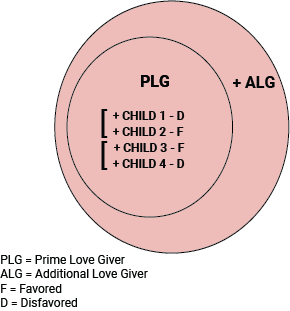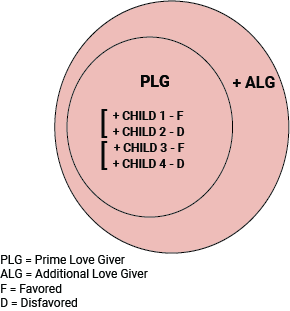Here are two real-life examples of 4-sibling families whom this author observed from the time they were growing up, a span of about 20 years each.
The first family came to see me when they had only two children and their older son was becoming quite unruly by the age of 10. The parents had consulted their local family services and were referred to a family therapist. After six visits they found that the fighting at home had subsided and were pleased with the result. At this point they decided there was no more need to continue the sessions. But about 4 months later the problems resurfaced, and by 7 months later, the mother, distraught by now, pleaded with me to see them on an urgent basis.
She came to the first session on her own to describe the problems at home. She declared that, no matter how much attention they felt they were giving their eldest, now 12-year-old son, he was still uncooperative and fought with his parents at every step. She said the fighting was about “everything”, ranging from what foods he ate, to outings with his friends, curfews, the clothing he wore to school, doing his homework, and more. She described him as stubborn and insubordinate at home and in school, although she felt he was not violent or aggressive and had a good heart. She was most fearful that he might come to blows with his father, who was constantly arguing with him and would sometimes hit or slap him out of frustration. She said she would try to intervene sometimes to cool the atmosphere, but admitted she often felt thankful for the father’s disciplinary measures, since she too felt her Anger was getting the better of her!
I asked her how their previous family therapy had been and she stated that her son had actually participated very little, since he tended to be a quiet and generally non-vocal boy. She mentioned however that her 8-year-old daughter had taken over the role of spokesman for the family in those sessions and was always able to explain everything to the therapist. She chuckled as she related that her daughter was quite the opposite of her son. She described her daughter as very vocal and far more verbally skilled than her brother, who was inclined to shy away from interaction and let his sister do the talking. She mentioned she felt the son “takes after his father” who is also the strong, silent type, while her daughter is more like herself in terms of engaging easily with others. She reported with some pride that her daughter was best able to relate to the therapist, and in fact was so inspired by the sessions that she was aspiring to be a family therapist herself one day.
The young woman added she hoped these troubles would soon be over, since she was pregnant with her third child, for which I congratulated her. Searching for the PLG, I asked her whether she or her husband is the more disciplining parent, and she replied she was unsure. I also inquired about which parent might be closer with which child. While she described herself as close with both her children, she noted that father and daughter had an undeniable bond of warmth, and mentioned that her parents, the maternal grandparents, often referred to her daughter as “Daddy’s girl”. Now forming the opinion that the father was the PLG, I gently informed her that her son must be quite jealous of the LOVE between father and daughter, and that this father should try to divert his LOVE and attention more toward his misbehaving son. Mulling over these ideas, she noted they made good sense. On speaking with her some weeks later, she reported that the father had begun engaging their son in the small business they conducted from home and teaching him about it, adding that this was going very well. I did not hear from her again until 5 years later.
By this time a new 5-year-old boy and a little girl of 31/2 had been born. She came to me because her 3-year-old baby daughter was whiny and defiant, but coyly she stated she was merely consulting me out of curiosity. She wondered why her little girl was so difficult to handle and was causing so much noise and trouble in the household, while her other three children were all so well behaved. She noted the little girl would hit her 5-year-old brother, scream wildly at anyone who tried to dress her, cry and carry on when it was time to go to bed, and refuse to do anything but stay around her mother and cling to her coattails. She remarked the little girl was happiest when she stayed home with her mother and played quietly, noting it seemed she wanted nobody else around but was content to play alone all day long near her mother while the older children went out.
Knowing this mother was well familiar with my thinking and DOLF theory, I had no hesitation in reminding her of my previous opinion that her husband was PLG to the children, to which she readily agreed. Wishing to confirm my analysis when her family still had 3 children, I asked about the temperament of her 5-year-old son, and she was happy to report that he was of a very sweet and loving nature, and well liked by everyone. (Remember that this Favored personality adjustment is typical of a third-born child, as long as there isn’t a fourth one born.) She mentioned he is very mature for his age and likes to join his older brother and father in their activities together in their father’s business, which they all helped run out of the garage. This reaffirmed to me that the 5-year-old was Favored and enjoying a warm relationship with the PLG. Now I could hypothesize that his younger sister was feeling Disfavored by comparison with this five-year-old boy, and that she felt she was losing the sibling battle with her brother for the LOVE of their father. The remedy then for this youngest daughter’s poor behavior was that she needed to be reassured of her father’s LOVE for her.
From here on, my explanation to this lady was brief and simple. I showed her that the pattern of Favoritism was the very same now as it had been with her older two children. I drew a diagram showing the typical pattern of a 4-child family, which always consists of 2 groups of 2 siblings who compete with each other:
 As I spoke gently to this young mother and gave her room to draw her own conclusions, it soon became clear to her that her youngest girl was desperately competing with her 5-year-old brother for the acceptance, attention and LOVE he was getting from their PLG father. Not surprisingly, as predicted by DOLF theory, the younger son and his littlest sister had now joined up to form a second competitive grouping of their own. They were competing with each other for LOVE and attention and it was obvious that the little girl was feeling Disfavored by their PLG father as compared with her older brother. She perceived her brother as WINNING the all-important SIBLING RIVALRY for LOVE.
As I spoke gently to this young mother and gave her room to draw her own conclusions, it soon became clear to her that her youngest girl was desperately competing with her 5-year-old brother for the acceptance, attention and LOVE he was getting from their PLG father. Not surprisingly, as predicted by DOLF theory, the younger son and his littlest sister had now joined up to form a second competitive grouping of their own. They were competing with each other for LOVE and attention and it was obvious that the little girl was feeling Disfavored by their PLG father as compared with her older brother. She perceived her brother as WINNING the all-important SIBLING RIVALRY for LOVE.
This woman did not return to my office, but on meeting her by chance about a year later she informed me that she could now truly understand what I had been talking about, and that things were going relatively well for all her children. All the same, she remarked that she wondered at how strange and miraculous it was that such a predictable pattern all could unfold so vividly before her eyes.
Another 4-Sibling Family
The second 4-sibling family is one I had known for many years. The parents had two children of the same sex of which the first was Favored and the second Disfavored. They were thrilled when they finally had a third child of the opposite sex, who of course was Favored, and later a fourth child arrived who was of the same gender as the third.
I did not see this family for many years and we almost lost touch with each other. However, another friend happened to bring us together, and because I had not met the fourth child, I took the opportunity to ask my friend how things were going, particularly with the last child, who was 6 years old by now. Without hesitating, my friend described her latest child as a “monster”. She didn’t go into much detail, but mentioned that this one was the most manipulative and troubling of all her children, and told me she vowed to have no more children after this one.


